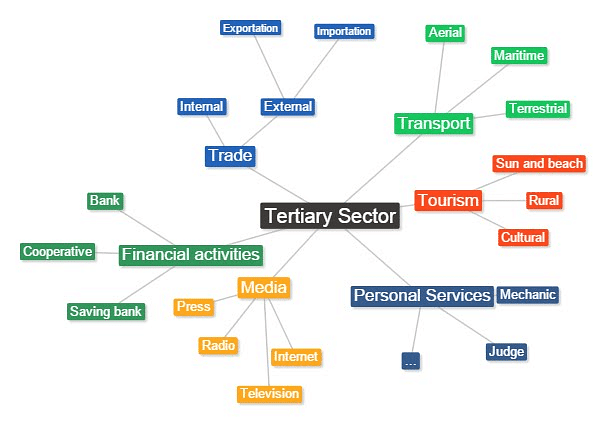NCERT Solutions for Class 10 Economics Chapter 2 - Sectors of the Indian Economy
Page 23
Q1. What does the history of developed countries indicate about the shifts that have taken place between sectors?
Ans. The history of developed countries shows that economies typically shift from the primary sector (agriculture) to the secondary sector (manufacturing) and eventually to the tertiary sector (services). Initially, agriculture dominates, then as farming efficiency improves, workers move to industry, and later, as income rises, the service sector becomes the largest in both production and employment.
Q2. Correct and arrange the important aspects for calculating GDP from this Jumble.
To count goods and services we add the numbers that are produced. We count all those that were produced in the last five years. Since we shouldn’t leave out anything we add up all these goods and services.
Ans.
- To calculate GDP, we count only the final goods and services produced within a country in a given year.
- We do not add intermediate goods to avoid double counting.
- We don't simply count the quantity of items produced (like the number of cars or computers). Instead, we use the monetary value of these goods and services.
Q3. Discuss with your teacher how you could calculate the total value of a good or service by using the method of value added at each stage.
Ans. To calculate the total value of a good or service using the value-added method, you add up the value added at each step of production:
Identify Steps: Break down the production into stages (like raw materials, processing, final product).
Find Value Added: Subtract the cost of inputs from the value of output at each stage.
Add Up Values: Sum the values added at all stages to get the total value of the final product.
For example, if wheat is made into flour and then into bread, add the value added by the miller and the baker to get the total value of the bread.
Page 27
Q1. Complete the table using the data given in Graphs 2 and 3 and answer the question that follows. Ignore if data are not available for some years.

What are the changes that you observe in the primary sector over a span of forty years?


Ans.

The share of the primary sector in GDP has gone down from 40% in 1973-74 to 10-15% in 2013-14. At the same time, the share of the primary sector in employment has gone down from 71% to 44%. This is because the share of secondary and tertiary sectors has gone up.
Q2. Choose the correct answer: Underemployment occurs when people
(i) do not want to work
(ii) are working in a lazy manner
(iii) are working less than what they are capable of doing
(iv) are not paid for their work
Ans. (iii) are working less than what they are capable of doing
Underemployment occurs when people are employed in jobs that do not fully utilize their skills, education, or capacity, resulting in them working less than what they are capable of doing.
Q3. Compare and contrast the changes in India with the pattern that was observed for developed countries. What kind of changes between sectors were desired but did not happen in India?
Ans.
- Economic transitions in developed countries moved from primary (agriculture) to secondary (manufacturing) and eventually to tertiary (services) sectors.
- In India, while the tertiary sector has grown in GDP contribution, employment has not shifted similarly.
- A large part of the workforce remains in the primary sector, mainly agriculture, which produces much less GDP.
- The expected shift towards more jobs in the secondary and tertiary sectors hasn't happened.
- This has resulted in widespread underemployment, where people work in agriculture but not to their full potential.
- This situation highlights the need for more job opportunities in other sectors.
Q4. Why should we be worried about underemployment?
Ans.
- Underemployment means that many people, especially in agriculture, are working less than their potential.
- This hidden or disguised unemployment indicates that more people are involved in farming than necessary.
- Even if some people leave for other work, the agricultural production would not decrease.
- The problem is that despite growth in the secondary and tertiary sectors, they have not created enough jobs.
- This lack of job creation leaves a large number of people stuck in low-income and low-productivity jobs.
- This situation hampers economic growth and keeps many families' incomes low.
- It is crucial to create better employment opportunities outside agriculture.
Page 29
Q1. Why do you think MGNREGA 2005 is referred to as ‘ Right to work’ ?
Ans. MGNREGA 2005 is called the ‘Right to Work’ because it guarantees 100 days of employment per year to adults in rural areas who want to work. If the government fails to provide this work, it must pay unemployment allowances, ensuring that people have a legal right to work and financial support if jobs are not available.
Q2. Imagine that you are the village head. In that capacity suggest some activities that you think should be taken up under this Act that would also increase the income of people? Discuss.
Ans. As the village head, I suggest activities under MGNREGA 2005 that boost agriculture and income:
- Water Conservation: Build ponds, canals, and check dams to improve irrigation.
- Land Development: Leveling and soil conservation to make more land farmable.
- Roads: Improve rural roads for better access to markets.
- Afforestation: Plant fruit trees to provide extra income.
- Livestock Shelters: Build shelters and fish ponds to support animal husbandry and fishing.
Q3. How would income and employment increase if farmers were provided with irrigation and marketing facilities?
Ans. Providing irrigation and marketing facilities boosts income and employment by:
- Increasing Crop Yields: Reliable water sources lead to higher production.
- Expanding Crop Variety: Farmers can grow diverse crops, improving profits.
- Reducing Crop Failures: Consistent irrigation decreases the risk of poor harvests.
- Improving Market Access: Better facilities reduce costs and spoilage, leading to higher earnings.
- Creating Jobs: Building and managing these facilities generates employment opportunities.
Q4. In what ways can employment be increased in urban areas?
Ans. Employment in urban areas can be increased through:
- Promoting Service Industries: Expanding sectors like hospitality, healthcare, and IT creates jobs.
- Supporting Small and Medium Enterprises (SMEs): Encouraging local businesses and startups fosters job creation.
- Investing in Infrastructure Projects: Developing transport, utilities, and public facilities generates employment.
- Boosting Retail and Tourism: Enhancing shopping districts and tourist attractions increases demand for services.
- Providing Training and Education: Skill development programs align workers with industry needs.
Page 31
Q1. Look at the following examples. Which of these are unorganised sector activities?
(i) A teacher taking classes in a school
(ii) A headload worker carrying a bag of cement on his back in a market
(iii) A farmer irrigating her field (iv) A doctor in a hospital treating a patient
(v) A daily wage labourer working under a contractor
(vi) A factory worker going to work in a big factory
(vii) A handloom weaver working in her house
Ans. (i), (iii), (v) and (vii) are examples of activities in the unorganised sector.
Q2. Talk to someone who has a regular job in the organised sector and another who works in the unorganised sector. Compare and contrast their working conditions in all aspects.
Ans.
Organised Sector:
- Job Security: Generally secure with formal contracts.
- Wages: Regular, fixed payments.
- Benefits: Includes health insurance, retirement plans, and paid leave.
- Working Hours: Regulated with set hours.
- Work Environment: Safe and regulated.
- Legal Protections: Strong labor laws and grievance mechanisms.
Unorganised Sector:
- Job Security: Often insecure with temporary work.
- Wages: Irregular and sometimes daily.
- Benefits: Typically no benefits.
- Working Hours: Unpredictable and often long.
- Work Environment: Less regulated and possibly unsafe.
- Legal Protections: Limited legal protections.
Q3. How would you distinguish between organised and unorganised sectors? Explain in your own words
Ans.
The organised sector includes businesses with formal structures and clear regulations. Workers in this sector typically receive benefits such as health insurance and retirement plans. They have written contracts and receive regular wages, and the sector follows labor laws.
The unorganised sector consists of informal businesses where there are no formal contracts. Workers lack job security and often have unstable wages. They do not receive benefits, and examples include small shops, casual laborers, and freelancers.
Q4. The table below shows the estimated number of workers in India in the organised and unorganised sectors. Read the table carefully. Fill in the missing data and answer the questions that follow.

(a) What is the percentage of people in the unorganised sector in agriculture?
(b) Do you agree that agriculture is an unorganised sector activity? Why?
(c) If we look at the country as a whole, we find that ———% of the workers in India are in the unorganised sector. Organised sector employment is available to only about ———% of the workers in India.
Ans.

(a) The percentage of people in the unorganised sector is 82.74%.
(b) Yes, agriculture is largely an unorganised sector activity because:
- No Formal Contracts or job security for workers.
- Irregular Income due to seasonal and crop-dependent earnings.
- No Fixed Hours; work depends on crop needs.
- Lack of Benefits like health insurance or pensions.
- Low Regulation with minimal labor law enforcement.
(c) If we look at the country as a whole, we find that 82.74% of the workers in India are in the unorganised sector. Organised sector employment is available to only about 17.26% of the workers in India.
Page 35
Q1. Fill in the blanks using the correct option given in the bracket
(a) Employment in the service sector _________ increased to the same extent as production. (has / has not)
(b) Workers in the _________ sector do not produce goods. (tertiary / agricultural)
(c) Most of the workers in the _________ sector enjoy job security. (organised / unorganised)
(d) A _________ proportion of labourers in India are working in the unorganised sector. (large / small)
(e) Cotton is a _________ product and cloth is a _________ product. (natural / manufactured)
(f) The activities in primary, secondary and tertiary sectors are _________. (independent / interdependent)
Ans:
(a) Employment in the service sector has not increased to the same extent as production
(b) Workers in the tertiary sector do not produce goods.
(c) Most of the workers in the organized sector enjoy job security.
(d) A large proportion of labourers in India are working in the unorganized sector.
(e) Cotton is a natural product and cloth is a manufactured product.
(f) The activities in primary, secondary, and tertiary sectors are interdependent.
Q2. Choose the most appropriate answer.
(a) The sectors are classified into public and private sector on the basis of
(i) employment conditions.
(ii) the nature of economic activity.
(iii) ownership of enterprises.
(iv) number of workers employed in the enterprise.
Ans: (iii) ownership of enterprises
The primary distinction between the public and private sectors lies in the ownership of the enterprises. Public sector enterprises are owned and operated by the government, while private sector enterprises are owned and operated by private individuals or organizations.
(b) Production of a commodity, mostly through the natural process, is an activity in ______________ sector.
(i) primary
(ii) secondary
(iii) tertiary
(iv) information technology
Ans: (i) primary
The primary sector involves the production of commodities mostly through natural processes, such as agriculture, mining, and fishing.
(c) GDP is the total value of _____________ produced during a particular year.
(i) all goods and services
(ii) all final goods and services
(iii) all intermediate goods and services
(iv) all intermediate and final goods and services
Ans: (ii) all final goods and services
GDP (Gross Domestic Product) measures the total value of all final goods and services produced within a country during a particular year. It excludes intermediate goods to avoid double counting.
(d) In terms of GDP the share of tertiary sector in 2013-14 is _________ per cent.
(i) 20 to 30
(ii) 30 to 40
(iii) 50 to 60
(iv) 60 to 70
Ans: (iii) 50 to 60

Q3. Match the following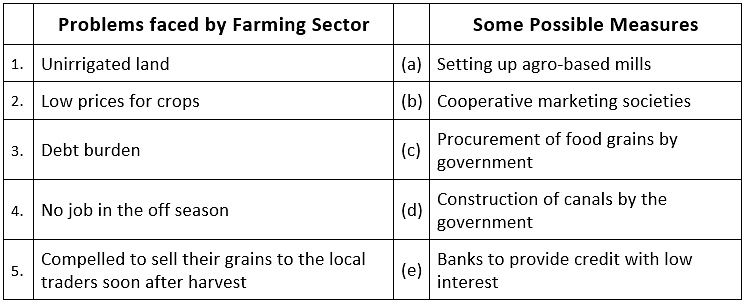
Ans:
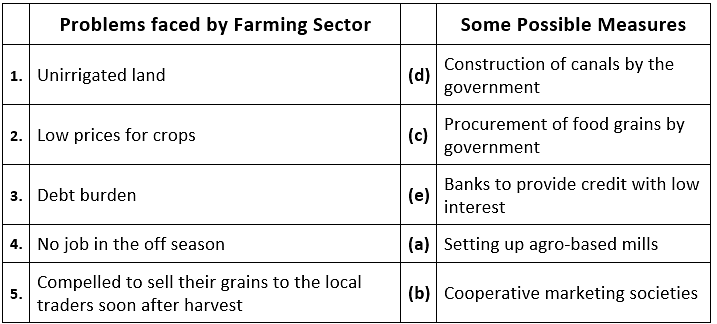
Q4. Find the odd one out and say why.
(i) Tourist guide, dhobi, tailor, potter
(ii) Teacher, doctor, vegetable vendor, lawyer
(iii) Postman, cobbler, soldier, police constable
(iv) MTNL, Indian Railways, Air India, Jet Airways, All India Radio
Ans:
(i) Tourist Guide
He is appointed by the government, while dhobi, tailor and potter belong to the private sector.
(ii) Vegetable Vendor
He is the only person who works in the primary sector, while others work in the tertiary sector.
(iii) Cobbler
The rest are workers in the public sector or organised sector, while his profession is part of the private sector.
(iv) Jet Airways
It is a private enterprise, while the rest are government undertakings, owned by the Government of India.
Q5. A research scholar looked at the working people in the city of Surat and found the following.
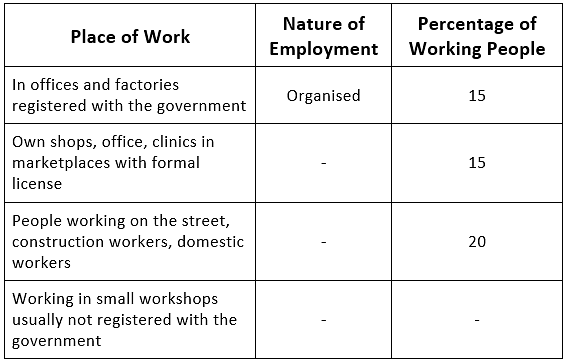
Complete the table. What is the percentage of workers in the unorganised sector in this city?
Ans:
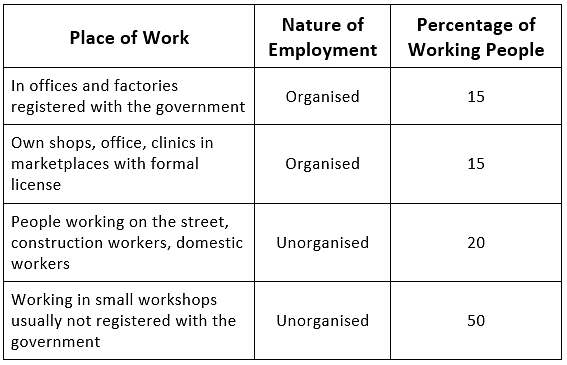
The percentage of workers in the unorganised sector in this city is 70% (50+20).
Q6. Do you think the classification of economic activities into primary, secondary, and tertiary is useful? Explain how.
Ans:
- Yes, the classification of economic activities into primary, secondary and tertiary is useful on account of the information it provides on how and where the people of a country are employed.
- Also, this helps in evaluating as to which sector of economic activity contributes more or less to the country’s GDP and per capita income.
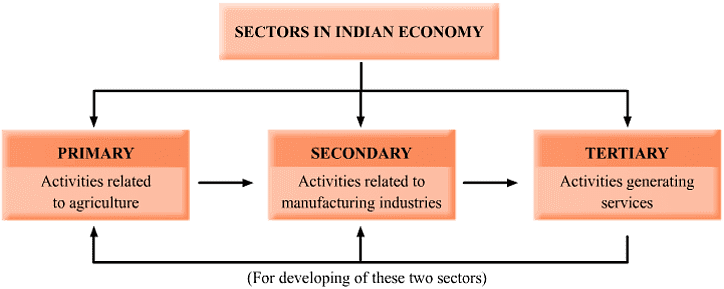 Classification of Economic Sectors
Classification of Economic Sectors
- It is necessary to classify economic activities into these three basic sectors for smooth economic administration and development.
Q7. For each of the sectors that we came across in this chapter, why should one focus on employment and GDP? Could there be other issues which should be examined? Discuss.
Ans:
- Employment and GDP are two of the most important factors in the development of a country.
- They help in determining two important things—per capita income and productivity.
- Hence, in each of the three sectors, employment rate and status, as well as its contribution to the GDP, help us understand how that particular sector is functioning and what needs to be done to initiate further growth in it.
- Other issues that should be examined: literacy rates, poverty and nutrition as well as basic health care facilities.
Q8. Make a long list of all kinds of work that you find adults around you doing for a living. In what way can you classify them? Explain your choice.
Ans: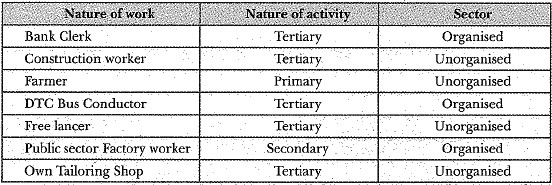 We have classified them according to the nature of the activity and according to their sector. This is a useful process as it is an easier way to layout the information.
We have classified them according to the nature of the activity and according to their sector. This is a useful process as it is an easier way to layout the information.
Q9. How is the tertiary sector different from other sectors? Illustrate with a few examples.
Ans:
- The tertiary sector is different from the other sectors because it does not manufacture or produce anything.
- For this reason, it is also known as the service sector.

- It aids the primary and secondary sectors in development.
- The tertiary sector involves services like transport, storage of goods, communications, banking and administrative work.
Q10. What do you understand by disguised unemployment? Explain with an example each from the urban and rural areas.
Ans:
- Disguised unemployment is a form of underemployment where one has a job, but the work they are doing is less than their potential.
- It is not apparent as compared to someone without a job who is clearly unemployed.
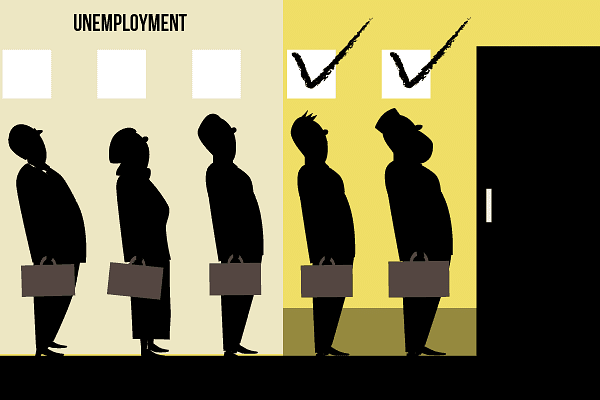
- In rural areas, this can be seen in the farming community where all members of a family might be working on a farm even though so many hands are not required.
- They do so because of lack of another job. In urban areas, disguised unemployment can be seen in the service sector where painters, plumbers, repairpersons and those doing odd jobs have work, but they may not find daily or regular employment.
Q11. Distinguish between open unemployment and disguised unemployment.
Ans:
- Open unemployment is when a person has no job in hand and does not earn anything at all.
- On the other hand, disguised unemployment is mostly found in the unorganised sector where either work is not consistently available or too many people are employed for some work that does not require so many hands.
Q12. “Tertiary sector is not playing any significant role in the development of Indian economy.” Do you agree? Give reasons in support of your answer.
Ans: No, this statement is not true. Over the past four decades (1970-2010), the tertiary sector has become the largest producer. This growth in the service sector is due to several factors:
- Demand for essential services like healthcare, education, security, and finance.
- Emergence of new services like IT.
- Growth of primary and secondary sectors.
- Increased demand for services driven by rising per capita income.
- The GDP share of the tertiary sector has grown from around 40% in 1973-74 to more than 50% in 2013-14.
Q13. Service sector in India employs two different kinds of people. Who are these?
Ans:
(i) Highlight skilled and educated people: service sector in India employs them in multinational companies, public sector and several private enterprises. They are an asset as they add up high income in the National Income of the country.
(ii) Low skilled and less educated people: They are also employed in the service sector, but most of them are uneducated and work in unorganised sectors. They are employed as painters, plumbers, repairpersons, etc.
Q14 Workers are exploited in the unorganised sector. Do you agree with this view? Give reasons in support of your answer.
Ans:
- Workers are exploited in the unorganised sector. I agree with this view. The unorganised sector does not offer any job security and are outside the control of the government.
 Unorganised Sector
Unorganised Sector
- Neither does it allow for scope of trade or workers’ unions. Workers can be easily exploited in this scenario.
- The workers have no job security and no medical benefits. They do not get extra pay for overtime.
Q15. How are the activities in the economy classified on the basis of employment conditions?
Ans: They are mainly classified in two types:
(i) Organised Sector
- The enterprises or place of work where the terms of employment are regular and therefore, people have job security.
- They have to follow its rules and regulations which are given in various laws such as the Factories Act, Minimum Wages Act, Payment of Gratuity Act, shops and establishments Act, etc.
- They work only fixed number of hours. Workers enjoy benefits like paid leave, Provident fund and medical benefits.
(ii) Unorganised Sector
- The enterprises or place of work are not registered by the government and does not follow any rules or regulations.
- There are no terms of employment.
- Workers do not enjoy security of employment.
- Workers do not enjoy any benefits.
Q16. Compare the employment conditions prevailing in the organised and unorganised sectors.
Ans:
- The employment conditions prevailing in the organised and unorganised sectors are vastly different.
- The organised sector has companies registered with the government and hence, it offers job security, paid holidays, pensions, health and other benefits, fixed working hours and extra pay for overtime work.
- On the other hand, the unorganised sector is a host of opposites.
- There is no job security, no paid holidays or pensions on retirement, no benefits of provident fund or health insurance, unfixed working hours and no guarantee of safe work environment.
Q17 Explain the objective of implementing the MG NREGA 2005.
Ans: The objective of implementing the MG NREGA 2005 are:
- To increase the income and employment of people.
- Every state/region can develop tourism, regional craft, IT, etc. for additional employment.
- The central government made a law implementing the right to work in 200 districts.
- MGNREGA aims to provide employment of 100 days. If it fails to do so, it will give unemployment allowances to the people.
Q18. Using examples from your area compare and contrast the activities and functions of private and public sectors.
Ans:
Q19. Discuss and fill the following table giving one example each from your area.

Ans:

Q20. Give a few examples of public sector activities and explain why the government has taken them up.
Ans:
AIIMS: To provide quality health services at a reasonable rate was the main purpose of the government to start this, besides medical education.
Railways: only the government can invest a large sum of money on a public project with long gestation period. And also to ensure and provide transportation at cheap rates.
Electronic Power Generation by NTPC: The government has taken this up to provide electricity at a reasonable rate to consumers.
Q21. Explain how public sector contributes to the economic development of a nation.
Ans:
- The public sector plays a vital role in contributing to the Human Development Index via its functioning in health and education services.
- Also, by buying food grains at a “fair price” from farmers, providing electricity, water, postal services at low rates, the government ensures that the people have a good living.
- It utilises taxes and grants to pay for the same.
- Thus, it plays a vital role in adding to the economic development of a nation, based on its human development situation.
Q22. The workers in the unorganised sector need protection on the following issues: wages, safety and health. Explain with examples.
Ans: The workers in the unorganised sector need protection on the following issues: wages, safety, and health.
- Wages: Wages and working hours are not uniform. For example, in the construction sector, labourers are employed on a daily basis. There is a need for proper implementation of a minimum wages act set up by the government to protect such workers from economic exploitation.
- Safety: The workers' safety is secondary to the company’s profits. For instance, miners working in private mining companies suffer grievous injuries (and many a time, even die) due to inadequate safety gear and norms. Governments of most nations have now laid down strict rules for private enterprises to ensure workers’ safety but they are not followed by the unorganised sector.
- Health: Most companies in the unorganised sector do not provide health insurance to their employees. Some of these might be involved in dangerous production processes that may harm a worker’s health in the long term. For example, there is no sick leave for labourers working on daily wages.
Q23. A study in Ahmedabad found that out of 15,00,000 workers in the city, 11,00,000 worked in the unorganised sector. The total income of the city in this year (1997-1998) was ₹60,000 million. Out of this ₹32,000 million was generated in the organised sector. Present this data as a table. What kind of ways should be thought of for generating more employment in the city?
Ans:
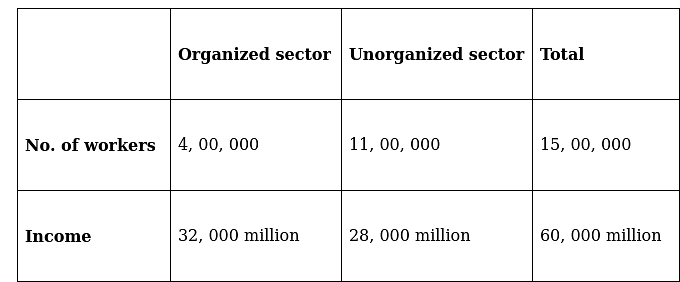
- It is clear that while a larger portion of workers is working in the unorganized sector, the per capita earning of those in the organized sector is more.
- The government should encourage entrepreneurs in the unorganized sector to change them into the organized sector.
- Moreover, the government should introduce some incentives so that more industries could be opened up in the organized sector.
Q24. The following table gives the GDP in Rupees (Crores) by the three sectors:
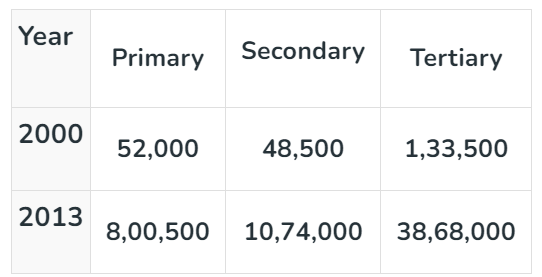
(i) Calculate the share of the three sectors in GDP for 2000 and 2013.
(ii) Show the data as a bar diagram similar to Graph 2 in the chapter.
(iii) What conclusions can we draw from the bar graph?
Ans:
(i) In 2000
Primary sector = 22.22%
Secondary sector = 20.73%
Tertiary sector = 57.04%
In 2013
Primary sector = 13.94%
Secondary sector = 18.70%
Tertiary sector = 67.36%
(ii)

(iii) The conclusion can be drawn from the bar graph that the share of the tertiary sector to GDP has increased by 10 percent while that of the primary sector is almost halved and the secondary sector has grown by 2 percent in the last 13 years.
|
63 videos|445 docs|87 tests
|
FAQs on NCERT Solutions for Class 10 Economics Chapter 2 - Sectors of the Indian Economy
| 1. What are the three sectors of the Indian economy? |  |
| 2. How does the primary sector contribute to the Indian economy? |  |
| 3. What role does the secondary sector play in industrial development? |  |
| 4. Why is the tertiary sector important for economic growth? |  |
| 5. How do the sectors of the economy interlink with each other? |  |

|
Explore Courses for Class 10 exam
|

|
